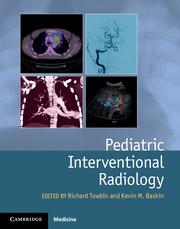8 - Vascular interventions
Published online by Cambridge University Press: 05 June 2015
Summary
General angiographic considerations
Introduction
Most vascular interventional techniques that were initially developed for the treatment of adult vascular disease can be applied to the pediatric patient, providing appropriate technical modifications are made. There are issues specific to pediatric patients that require consideration in order to safely and successfully use vascular interventional techniques in this population. The problems that need to be overcome include the small patient size, the child's inability to cooperate, vulnerability to hypothermia and blood loss, volume limits for fluids and contrast media, the small size and fragility of access vessels, and, in the neonate, physiological differences related to fetal circulation. The wide range of patient sizes and clinical indications require that the operator be familiar with the vascular problems affecting children and techniques required to treat them. In addition, the interventionalist should be experienced with pediatric sedation and resuscitation, fluid administration, drug dosages, and contrast injection volumes for children of all ages and sizes. Catheterization supplies including needles, guide wires, sheaths, and other materials must be available in a range of sizes appropriate to the child being treated, and the operator should be familiar with the technique of custom shaping of catheters.
Indications
A large proportion of angiographic studies in the pediatric population are performed in conjunction with endovascular therapies (Table 8.1).
Current indications for diagnostic cerebral angiography include central nervous system (CNS) vasculitis, hemorrhage, cerebral ischemia, trauma, and investigation of vascular malformations, strokes, and vasospasm prior to endovascular therapy. Visceral angiography is most commonly indicated to investigate and treat hypertension, ischemia or occlusion related to organ transplantation, gastrointestinal bleeding, hemorrhage after penetrating or blunt trauma, varicoceles, and vascular malformations. Indications for extremity angiography include vascular mapping prior to surgical reconstruction of complex hand and foot anomalies, following penetrating injury and to investigate ischemic vasculopathy. In addition to the investigation of congenital heart disease, thoracic angiography is needed to study and treat hemoptysis, cyanosis (e.g., pulmonary AV malformations), and pulmonary embolism.
- Type
- Chapter
- Information
- Pediatric Interventional Radiology , pp. 404 - 476Publisher: Cambridge University PressPrint publication year: 2015
- 1
- Cited by



